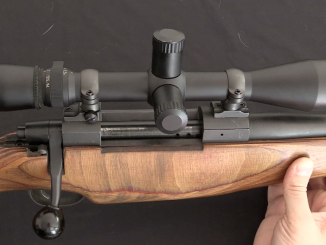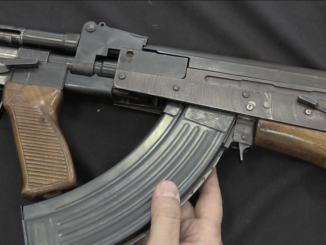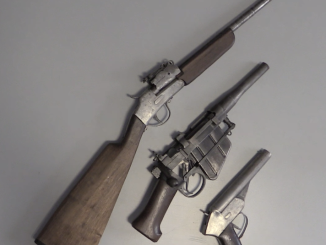The Zagi is one of the more prolific of the Croatian homeland War submachine guns. It was developed with the intention of making substantial numbers, and a lot of capital was put into the PHTO (First Croatian Arms Factory, or Prva Hrvatska Tvornica Oružja) for its manufacture. This included polymer molding tools to produce the lower frame, buttplate, and pistol grip for the gun (all of which were based on HK style parts).
Mechanically, the Zagi design is a Sten gun internally, with Sten bolt and fire control group. The stock is HK is style, but attaches to the receiver like a Sten stock. It is chambered for 9x19mm, and uses standard MP40 magazines. A suppressed version was also made with an MP5SD-style vented barrel, but I don’t have access to one of those to show today.
Total production ended up being about 2000 guns in 1991. They were used in Croatia, but rendered obsolete fairly quickly as more modern arms were acquired. A few years later, many were sent to Bosnia as military aid in the Bosnian fight for independence (and the Bosnians actually produced their own copy as well).
A big thanks to the Croatian Police Museum (Muzej Policije) in Zagreb for giving me access to film this cool piece for you! Check them out at:
https://muzej-policije.gov.hr
Further thanks to the Sisal Municipal Museum for access to their preproduction example!




I am wondering if barrel shroud extending past muzzle of barrel is simple due to manufacturing limitations or it was supposed to be sort of flash-hider? If 2nd how effective it was whilst firing in low-light condition in comparison to early STEN conical muzzle device, see 1st photo from top http://modernfirearms.net/en/submachine-guns/great-britain-submachine-guns/sten-eng/ ?
Its possible they experimented with ideas they thought would be novel and working, but basicly companies producing all these smgs had low knowledge of firearms (as they were not primarily gun factories), so sometimes they threw stuff at the wall and hope it sticks, so to say.
Stock is nice in its closing, but being straight and so high, and sights so low, its hard to aim. Why theres a bend in the end of buttstock, that does not contour to shoulder, but opposite? Why you have that huge barrel shroud, when you could grasp the front of the gun by that long magwell? It would be better if shroud is short, like in Pleter.
For example of dubious knowledge practice, in one perfectly nice sniper rifle (described before on channel), there are holes drilled near muzzle for sorta of muzz. break, but in wrong direction!
And did the fixed-stock pre-production version have a similar length of pull?
The thing that leaves me a little baffled with these things is that we knew, by the time they were building these, that a Uzi-style wrap-around bolt was a better idea than a STEN-style setup. Why the hell did they go with the STEN, rather than build something with even a Walther-style overhanging bolt? Shorter, handier weapons would have resulted, with longer barrels.
Makes ya wonder…
Sort of like P.A. Luty’s “table leg” SMG, they may have been looking at it from the “What’s the simplest design to make in a hurry with what we’ve got?” standpoint.
They may not have known about Maxwell Atchison’s Model 1957 prototype, that not only used an MP-40 magazine but used its magazine housing as well to create a very “Uzi-like” setup;
https://en.topwar.ru/89638-pistolety-pulemety-maksvella-atchissona-ssha.html
Although I suspect the “production” version might have wrapped a plastic or wood grip around that housing to avoid the shooter’s hand looking like it had been on a waffle-iron after a couple of magazines.
cheers
eon
One of the things I’m sort of surprised by in the whole “3D printed firearms” space is that few of the designs are looking at “How do we do this as quickly/cheaply as possible” vs. “How do we do this with a printer…?”
You’d be a lot better off if you were to design for a square-tube or round-tube receiver, and 3D print just the grip and other things that are easily done in a plastic-based printer. Were you to combine what’s generally available at your average industrial supply house with what you can do that’s actually appropriate to a 3D printer, I think your results would be a lot better…
Quite, and “All the fuss” oh no! A gun. A not very good one.
Show me one good plastic 3d printed gun; as someone who has some understanding of guns albeit via here. Zero, none. Pour some Confederate brass into some sort of dung mold’ing mold thing. And file. Gettysburg movie “Your Prisoner Sir; after pulling the trigger.” I suppose he did the right thing, and not shooting him.
“Show me one good plastic 3d printed gun(…)”
Be watchful against https://www.youtube.com/watch?v=oXSjTzt_Kug so far few hundreds shots given so it is not time for conclusions yet, but if I understand it correctly enough test are under way.
Kirk,
I have the utmost respect for 3D printing designers (who have to know everything home gunsmiths know and 3DP programming), but the tech/toy seems to mostly be a distraction from home gunsmithing best practices and materials.
It seems like a promising idea for extremely restrictive jurisdictions, but in the US combining everything you wrote (with which I agree completely) with the unrestricted availability and affordability of most gun parts (e.g. stronger, better polymer pistol grip frames) one might conclude that the 3DP aspect is almost entirely counterproductive.
Polymer clay, you can mould plastic; triggers etc. 3d Metal printing, maybe.
3d plastic guns, oh no! A .22 thats 8 times a big. As a pipe, with a hole in it; and smacking another pipe with a rim pin into it with your palm.
Plastic 3d guns are a joke currently.
Right. Seamless aircraft tubing is a superior building material in every way, and easily worked using common tools that are cheaper than 3D printers.
Saying Uzi style bolt is better is very similar to Bulpup configuration of rifle, on paper its better, but in practice there has not been a complete domination of one style over the other.
Much better question was, why hasnt smg production been standardized to only single model, with single type of magazine.
But then you would not have such variety of guns, and diversity is an (in)famous word of the day in our times, heh.
Well, as far as magazine standardization, quite a few SMGs use Uzi magazines. There is also a trend with semiautomatic 9mm carbines to use Glock magazines, especially the 30-round originally intended as a “police only” item for the Glock 18 machine pistol. There seem to be far more of those 30-round magazines around than there are Glock 18s.
If anybody was to pick a single SMG to be the standard, the Steyr Mp-81 would probably be a reasonable choice, being an Uzi analogue that’s rather easier to mass-produce. Remember, the Uzi was designed around what Israel had to work with in 1954, hence the extensive use of steel stampings. The Steyr has more parts that could be moulded from plastic or even 3D printed today.
The Steyr TMP aka Brugger & Thomet TP9 is an even more modern design that would probably be the best all-around “World Sub-Machine Gun”. Its one drawback would be its 900 R/M rate of fire. A rate reducer as on the old Vz 61 Skorpion would probably be a good idea.
clear ether
eon
Eon, when saying magazine standardization (as well as in models- imagine UK in 1941. making 10 different smgs all at once), I had in mind primarily these croatian 1991-1992. submachineguns, not overall worldwide of all made from 45. to the end of century. However, Uzi magazine is as close to mass issued perfection it can get, though probably there are some other types that are even better, but more expensive and complicated to make, or having some specific edge in quality, stemming from high class gun company (like Walther MPL/MPK)
“(…)Shorter, handier weapons would have resulted, with longer barrels.(…)”
If https://guns.fandom.com/wiki/Zagi_M91 in regard to weight is is actually lighter than Uzi (3,41 kg vs 3,7 kg). Also Zagi layout allows greater flexibility in grip shaping and as such be more easily made fit for hand anatomy.
I wonder, “how low can you go”, could you make it from 3,41 kg to 2,40 kg; if you were to take a gun of its, for example Zagi size more or less, with fixed weight for bolt, mag and barrel, but aimed for savings in receivers, both lower (made from plastic), and upper, made from composite tubing of 1mm steel tube press fit into 2mm (or such) aluminum tube, that would act as outside reinforcement.
Stock could be also plastic or very skeletonized, but in any case not shitty grease gun wires, as aim is to have something very ergonomic friendly for masses.
People handy with math and geometry could even calculate what would weight of that contraption be, compared to regular 2mm or such tubing used for all Stenlike and other similar subm.guns.
Also, moving the grip towards the magwell would save in middle deadweight (look how it is in zagi, plastic cover just wasteing space and weight) as well as shortening the stock by different length of pull.
If one trains “nose to charging handle” with an AR, that means face right behind the grip. Using a mag in the grip, with a decent amount of free recoil travel, places quite a bit of receiver there. Put a cheek piece on it for an ergonomic cheekweld while still using a minimalist, fully collapsing stock. That is one of many updates I’m doing on a project right now.
In a situation where you want guns as soon as possible
the design is going to be dictated by what machines you have available
a STEn bolt ties up your big milling machines for a lot less time than an Uzi bolt
most of the work on a STEn bolt can be done on lathes, with easily made and re ground tools
there’s a bit of milling for the clearances and feed rib on the underside of the bolt and the cuts for the extractor, and a few holes to drill on a drill press
there’s so much more milling on an UZI style bolt
so much more time spent on the milling machines,
so much more metal to buy just to turn into swarf
so much more time for skilled guys to sharpen or to change the inserts on those expensive milling cutters…
some of the cuts on an UZI style bolt will also require special long tooling to be made up and maintained by your tool makers and setters,
for example the bolt face recess and firing pin in the UZI bolt
on the STEn, those could all be done on one setting on either a centre lathe or a capstan lathe, with standard lathe tools.
on a capstan lathe, once it is set up, all you need is someone semi skilled to wind a handle, and a foreman to watch over about a dozen lathes and operators, or even better if you have some automatic lathes.
As Truby and Minnery point out in Improvised Modified Firearms (1975- now free online at archive.org), probably more “home-grown” Sten guns have been built worldwide in the last eight decades than any other single weapon.
The Danish underground began building Sten MK II copies about a week after they got their first “real” ones from SOE. The Indonesian revolutionaries did likewise as early as 1944.
Even the Israelis’ first home-grown SMGs were Sten MK II copies made in literally underground workshops at kibbutzes. They were helped immensely by the British throwing away shot-out SMLE 0.303in barrels. One SMLE barrel could be cut in two, bored up to 9mm, rifled and etc., resulting in two Sten barrels.
Sten MK IIs even showed up in the hands of the “Zapatista” resistance movement in southern Mexico a decade or so ago. Some were original but others were apparently once again “home-made”.
And this does not even include “official” factory-made Sten copies built by governments for their armies in places like Taiwan, Burma, and etc.
Shepperd and Turpin set out to design the simplest “machine carbine” that could be produced under Britain’s restricted wartime conditions. To judge by how many have been made in out-of-the-way places since 1940, I’d say they succeeded beyond their wildest dreams.
cheers
eon
This is the best comment regarding the production, yes you can make uzi bolt with milling (very complicated) but as Ero smg was made with investment castings (bolt and fcg parts), which is a process that was unavailable in the 1991. the most logical thing was lathe oriented round receivers and bolts.
Can a lathe style round bolt be made but recessed? Yes it can, like in Rhodesia Kommando LDP smg, its made smartly out of 2 parts, but such item to copy was unknown and unavailable in 1991. There are also examples of square bolts in 2 parts, like some ingram m11 ones.
As for Eons comment, I heavily agree that steyr mp81 is sweet spot as a product improved Uzi that is simplified for production, however maybe to some production facilities lower receiver made completely plastic would be too complicated at the time.
For tmp, there is one drawback – its locked breech design, and that could be iffy to fine tune in hasty production. Unless making tmp blowback only with heavy bolt.
IMO, its not paramount of having a small smg, but for such mass conscription instances, one that that is easy to handle and not too heavy, while sporting a good reliable magazine, 20-25 cm barrel and some reasonable safety, but most of all – low rate of fire, in 600 rps range.
Note that the Rhodesian SMG aka Sanna 77 in South Africa was basically a copy of the Ceska Zbrovjoka Samopal 23-26 “family”, dating to 1948. So the design was certainly “available” in 1991. It has been said by experts that the S26 series bolt can be made on a lathe, with the addition of a live center, an end mill, and a drill press for the really deep holes.
Add in some 1.5″ nominal ID Schedule 80 seamless steel tubing for the upper receiver and you’re good to go.
cheers
eon
Two pieces of seamless steel tubing; one fits inside the other with enough room run a bead on the smaller one. Run four beads of weld, for rails; machine on a lathe for smoothness. Cut opening in middle for where you’re going to put the breechface, and then just machine the bit you need as simply as possible; pin in place. Pin any additional weight you need in front of the inner tube that’s now your bolt, EDM a barrel from appropriate stock, and it’s “Hey! Presto!!” a submachinegun. With access to the right stock and a bit of judicious work, I’m pretty sure I could be cranking these out by the dozen in fairly short order. And, they’d be better balanced than the STEN copies…
You could do a design in square seamless tubing, and one in round. Either way, it’d work better than the plastic of a 3-D printer.
No need for rails, nor much of an upper either. Make the “telescoped bolt” a slide, with a screwed or pinned-in bushing at the front and the breechblock at the back like you said. The bushing rides the barrel, and the rear is indexed between the ejector and a small U-shaped cover / sight bridge at the back.
Please take note that Kommando is not the same as Sanna 77, Ian did a vid on it few years ago. Its is more simple, but not in all regards; I think that samopal has much simpler FCG, especially if compared also to Uzi, probably more reliable also.
This maybe wrong, but I honestly think my gas delay retracting diamond thing would function out of lego technic. Albeit with some metal… Hee! Yes semi auto. I hate every 3d plastic gun; why, as all are shit. Up your game computer nerds.
I am not wrong. Shit.
“(…)every 3d plastic gun; why, as all are shit(…)”
Please define was criteria must be meet so gun would not be classified as such.
Good movie that Gettysburg, my Pop bought it 4 Dvd’s or the like in a box; on poo tube now in bits. Lame like pure plastic 3d printed guns. Piss poor and shit, wank and crap. Prove me wrong, net nerds with plastic sex doll making manufacturing capability? No?? Oooh.
“I think it is going to be, very hard; but crack on, prove it.”